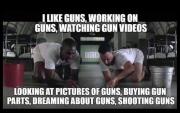I was reading in another topic when I saw someone mention this, and decided to explore exactly what natural point of aim is.
While I've discerned what it is, I'm a bit perplexed on how to determine and troubleshoot one's natural POA. I've experimented with one method where you swivel turret-style back and forth until coming to a naturally comfortable position. I've wound up with numerous results from off left to off right and then hi's and lows.
I'm requesting insight and advice on ways to more effectively establish my natural POA.




 Reply With Quote
Reply With Quote


